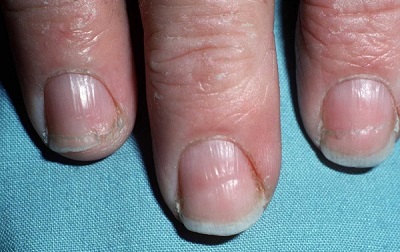I was working one day and suddenly caught sight of the ridges that had formed on my fingernails. The ridges had formed in a horizontal direction and were set pretty deep into my fingernails. I hadn’t observed these grooves earlier because they had not bothered me even for a second but after seeing them I became concerned and could not stop thinking how abnormal it was. What I have is Beau’s lines. Such a case can occur to lots of people, read on to find out the cause and how to deal with it.
What Is Beau's Lines?
Beau’s lines are grooves that are set deep into the nails of the fingers or toes and appear to be ridges or indentations in the plate of the nail. This nail condition is named after Joseph Honoré Simon Beau, a French physician who was the first one to describe the condition in 1846.
The horizontal nail ridges that are observed in this condition are not to be confused with other such nail conditions like Muehrcke lines and Mees’ lines. Muehrcke lines are characterized by hypopigmentation and target the nail bed without causing any indentations, while the Mees’ lines cause discoloration of certain areas of the nail plate. Moreover, Beau’s lines are entirely different from age-induced vertical ridges that travel from the cuticle to the fingertip.
What Causes Beau's Line?
Temporary stop in the production of nail cells by the body for even a day or two is the reason behind the formation of horizontal ridges in nails. Measuring the thickness of the Beau’s furrow is used as a way of calculating the duration for which the production of nail cells has been suspended. Moreover, the distance in between the Beau’s lines leading edge to the proximal nail fold from where the cuticle is visible can also be measured to find out the time duration of Beau's lines.
1. Local Trauma
Local trauma to the nail by a crushing blow of the hammer or by any other external force can also be the cause for Beau’s lines. The trauma to the nail can affect the nail matrix and stop it from growing for a temporary time period. However, the lines caused by local trauma usually go away once the nail starts growing again.
2. Systemic Problems
An infection or a high fever is usually the likeliest cause of this condition. However, other systemic problems might cause it as well, which may include drugs used in chemotherapy and diseases like diabetes. If a systemic problem is at the root of the condition rather than local trauma then the horizontal ridges in nails might show up on multiple fingernails and toenails.
3. Malnutrition
Malnutrition might be a reason for the formation of the horizontal nail ridges observed in this condition. Moreover, iron or zinc deficiency, a serious metabolic condition, anemia, a temporary condition or stressful event which interrupts the growth of nail cells can also be responsible for causingBeau’s lines.
How to Deal With Beau's Line
Development of the Beau’s lines is usually not under the control of anyone. However, these lines are nothing to worry about because they are harmless and therefore usually do not require any kind of treatment. Once the growth of the nail resumes, the ridges will grow out and you can simply file them off when they reach the edge of the nail.
However, if you want to hasten the healing process and take proper care of your nails with Beau’s line, then the following tips might prove to be extremely useful for you.
- You must moisturize brittle nails or have them trimmed after taking a bath.
- After washing your hands remember to apply a moisturizer on your nails.
- Use cotton gloves to cover the nails and cuticles at bedtime after moisturizing them properly.
- Acetone can dry nails, thus nail polish removers that contain it have to be avoided. Limit the use of nail polish remover to only twice a month.
- Antineoplastic drugs can induce Chromonychia which have some distinct forms. Melanonychia is its most frequent form which is characterized by dark pigmentation of nails observed in longitudinal, transverse or diffuse patterns.
The development of complex patterns is usually caused by the additive effect or synergy of agents of chemotherapy on the cellular proliferation of nail compartments.
